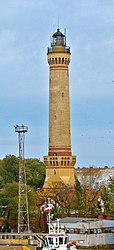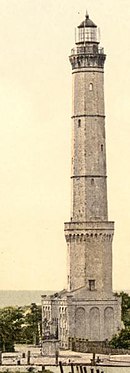Świnoujście lighthouse
| Świnoujście lighthouse | ||
|---|---|---|
| Place: | Świnoujście | |
| Location: | East bank of the Świna in Chorzelin (Easter Harbor) | |
| Geographical location: | 53 ° 54'57.6 " N , 14 ° 17'3" E | |
| Height of tower base: | 3.2 m npm | |
| Fire carrier height : | 68 m | |
| Fire height : | 68 m | |
|
|
||
| Identifier : | Oc WR 5s | |
| Scope knows: | 24 nm (44.4 km ) | |
| Scope red: | 9 nm (16.7 km ) | |
| Optics: | Fresnel lens | |
| Operating mode: | electric light bulb 4200 watts | |
| Construction time: | 1854-1858 | |
| Operating time: | since January 1, 1859 | |
| International ordinal number: | C2668 | |
The Świnoujście lighthouse (German: Leuchtturm Swinemünde ) is the tallest lighthouse on the Baltic Sea . The 68 m high tower is located on the eastern bank of the Świna (Swine) on the island of Wolin (Wollin) in Chorzelin (Easter Harbor), a district of Świnoujście (Swinoujscie).
history
In 1805 a so-called light booth was put into operation at the head of what was then the east packing plant. It was about a 6 m high construction made of wood, which diverted the light of an open fire with mirrors. The packing did not last long in the Baltic Sea, and with it the light booth fell into disrepair.
After almost 10 years of construction, the two piers at the Swinoujscie harbor entrance were completed in 1828. A lantern beacon was erected at the tip of the east pier, which was already known as the lighthouse of Swinoujscie. The height of the fire was about twelve meters. Several argand lamps were used for lighting, each surrounded by five to six semi-circular concave mirrors and operated with rapeseed oil . When the weather was good, the lights could be seen between eight and twelve nautical miles .
At the beginning of the 1850s, the Berlin senior building officer Wilhelm Severin was commissioned to design a massive lighthouse. In 1854 construction of the tower began in the colony Osternothafen. It was the first lighthouse made of ceramic bricks, with a height of more than 50 meters. On December 1, 1857, the lighting was put into operation on a trial basis. The official commissioning took place on January 1, 1859. The total cost was around 60,000 thalers.
In 1902 and 1903, the weathered outer shell of the lighthouse was removed and the tower covered with hard-fired facing bricks. For this purpose, a 60 m high scaffolding had to be erected. With the sheathing, the previously octagonal building was given a circular cross-section. The base building was fundamentally redesigned. The total cost was 79,500 marks .
The lighthouse has been operated electrically since the 1920s.
The tower was not hit during the air raid on Swinoujscie on March 12, 1945. However, bombs hitting nearby damaged the masonry. After the Second World War , Swinoujscie came to Poland. The lighthouse was put back into operation by the Polish port authority. It was not until 1959 that the war damage was repaired for the first time. In 1997 the structural condition of the tower was examined. Extensive renovation work on the outer shell was necessary, the damage of which, among other things, was made responsible for aggressive vapors from a transshipment station for chemical goods operated nearby. The tower was fully scaffolded again in 1998. The work was completed in 2000. Since then, the tower has been open to visitors again. In the base building is the Museum of Lighthouse Creatures and Marine Rescue ( Muzeum Latarnictwa i Ratownictwa Morskiego ).
technology
The tower is 68 m high in total. The lighting is at a height of 64.8 m. The mean diameter is 7 m, the mean wall thickness 1.5 m. Inside there is a spiral staircase .
The original lighting of the lighthouse consisted of an Argand lamp, the light of which was focused by a rigid, ring-shaped Fresnel belt lens . The focal length was 92 cm, the diameter 2 m. The price of the lens is estimated at 20,000 thalers. The Argand lamp used about 1 kg of rapeseed oil per hour. Depending on the season and the burning time, up to 16 kg of oil had to be carried onto the tower.
When the tower was rebuilt in 1902/1903, the tower was given an aperture carousel and thus an identifier . It consists of a 4 second light interval and 1 second dark phase. The shutter carousel was operated by a weight that sank down on a rope, similar to a pendulum clock . The weight was pulled back up with a hand crank.
In the 1920s, the lighting was switched to an electric 4200 W incandescent lamp. This is located in a tilting device together with a replacement lamp. If the incandescent lamp fails, the replacement lamp can be quickly replaced with the failed one. The aperture carousel has also been operated electrically since then.
literature
- Hellmut Hannes : From the beginnings of the Swinemünde lighthouse. (= Usedom-Wolliner Blätter. Issue 10, ISSN 1611-3322 ), Störr, Ostklüne 2006, ISBN 3-937040-14-5 .
See also
Web links
- Swinoujscie, east pier. Retrieved October 7, 2015 .


